The Wonder of It All
By Mary Rector-Gable
When Angelo Seminara was a little boy, he had a nervous habit of rubbing cotton balls in his hands. He said he couldn’t help himself. He was addicted to the softness and texture as they moved between his fingers. His mother begged him to stop, after she spent hours picking up little white pieces of furry cotton throughout the house. He couldn’t stop and instead hid them where his mother couldn’t find them.
Sometimes the world has a way of handing us the clues to our future. Angelo Seminara is one of only three hairdressers ever to have won British Hairdresser of the Year three times, sharing this distinction with Anthony Mascolo and Akin Konizi. (Trevor Sorbie has won the award four times.) In fact, Angelo has won dozens more awards including being named to the BHA Hall of Fame three times, winning Fellowship Hairdresser of the Year and the most coveted worldwide award (next to the BHA), the IAPP Grand Trophy. He was the International Creative Director at Trevor Sorbie in London, he’s currently Davines’ International Artistic Director, and in his spare time, he does hair for fashion and museum exhibits and advertising and fashion shoots. And he still cuts at least 40 clients behind the chair every month, which to this day, he says, is the most important part of his hairdressing life.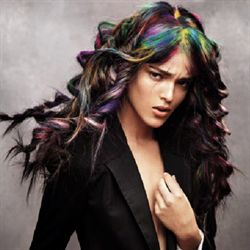
Unquestionably, the most fascinating thing about Angelo is the magical hair he creates. After seeing many of his award-winning looks, hairdressers from around the world study his collections to figure out how he created some of the most intricate styles ever seen in hair—such as the honeycomb and complex fishscale-inspired color that were both part of his winning 2012 BHA collection and the three-dimensional tumbling blocks of color from his Wonderland collection. When asked, Angelo just smiles and replies, “How do you think?”
At the roots of his creativity are a relentless curiosity and a sense of wonder. His excitement for discovering what’s new is parallel to a child who discovers for the first time that his legs will carry him. That spirit of adventure, that relentless curiosity and that unquenchable restlessness combine as the kindling that fuels Angelo’s constant bonfire of ideas. But Angelo seems to be aware that he sees through a different lens than most of us and he’s always anxious to share what he sees.
While we were together in Seattle recently, he asked for my phone and set it on the ledge of a window to tape the waves of the sea that were moving very slowly outside. He said, “It’s so beautiful. You’ll use that video someday.” Another time in New York, it was a rogue strand of yarn on a handmade blanket in an antique store being blown by the wind of a floor vent that mesmerized him. He’s more than just a collector of creativity; he’s a hoarder, with an iPhone and iPad that serve as his libraries of creative curation. He believes our brains are recorders. “They are always recording and recording and recording and the one with the most recordings wins,” he says. “As humans, we don’t push ourselves enough.”
Taking Root
Since Angelo was a young boy growing up in Melicucco, a small village on the southern tip of the Calabria region of Italy, he loved art—and has been consumed with color. “I started painting at about eight or nine years old, and I would paint everything—the sun, the waves of the sea, plants, animals, people—everything. I was very lucky to be chosen to have my paintings posted up on the walls in our little school. I loved to paint with heavy acrylics and sometimes I would paint so heavily, it would become more of a structure because I built the paint up so much. I never kept my paintings. I gave every one of them away. I don’t know why. I guess I have always wanted to share my art, even when I was young.”
In his traditional Italian family, Angelo was very close to his grandmother who grew her own garden, made her own clothes and bottled her own wine. “I’m sure my grandmother has never bought a tomato or a bottle of wine in her life. She is the most sustainable person I’ve ever met. It’s just how it was done in my home. I grew up in a very small town with only about 5,000 people and only a few minutes from the sea. I would spend my summers barefoot and swimming at the seaside, playing in the country and in tree houses I made myself. I love nature. I absolutely love the smells of being outdoors.” Angelo asked me if I was aware that the human brain can remember over 5,000 smells. I didn’t answer, but smiled, recognizing the familiar offering of stored information he’s always sharing. Angelo’s favorite smells? Bay leaves and a baby’s scalp, which he says is the most incredible perfume.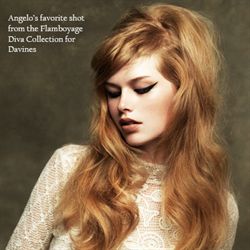
Angelo’s childhood is a bit reminiscent of the movie The Karate Kid, where the young novice endures a series of seemingly unrelated lessons from his Kung Fu master, later learning the teachings were essential to his ultimate goal. Angelo’s early training—from the ages of nine to fourteen—was from four cousins, each a “master” who would teach him something that would ultimately contribute to the extraordinary artist he is today.
The first cousin was a builder, who taught him to measure, form angles, construct straight walls and solid foundations. The second cousin was a tailor, and from him Angelo learned to stitch and fit and design. The third cousin was an automobile painter and taught him how to see color and to mix and apply paint—by eye and by hand, without the aid of a computer. The fourth cousin was a barber. But this cousin would not employ Angelo—telling his mother that he was too restless and ill-behaved to work in his shop. So Mrs. Seminara, determined that Angelo would work, arranged for her son to study with another barber—Pasquale Scattarreggia. He was a strict but accomplished master. Under the stern eye of this fourth master, everything started to come together.
“I worked in Pasquale’s shop for five years,” Angelo remembers. “His brother is Carmelo Scattarreggia—he worked with the clipper and did 40 haircuts a day. He was like the Flash Gordon of hair! I remember Pasquale was so strict. If I had any little spot on my trousers or shoes, he would send me home. And my mother would be so angry with me and send me back with proper trousers. But he was nice, too and we used to sit and play cards when there weren’t any clients. That’s what barbers do, you know, Mary. Play cards.” Again, sharing an important piece of information I was probably not aware of. “I took care of my first client when I was only 11 years old. He was a dead man.” Angelo had shared this piece of information on stage in Seattle while I interviewed him for an audience there after one of his shows last spring, but I didn’t realize he was actually serious. “A man came into the barbershop one morning and said he needed someone to shave this man for a funeral later that day. There was nobody else to do it, so I was brave and I told him I would do it. I went to the place and it was terrible. I did it, but I tell you I couldn’t eat for a week.”
The Wide World
For five years Angelo and Pasquale cut hair and played cards between customers. He loved the social aspect of the small town business, and he learned everything there was to know about anatomy, bone structure, head and facial shapes. But since Angelo is an artist—and a Pisces—it’s impossible for him to stay in one place for very long. He felt it was time to see what he could do with women’s hair and with the approval of his parents, he quit school, moved to Rome and lived in a hotel his sister owned in the city’s center.
“When we arrived to Rome, my mother opened the Yellow Pages and spotted a salon called TONI&GUY, which my sister said was in a good part of town,” he laughed. “Yeah, a very good part of town ‘near the Spanish Steps.’ We didn’t even know TONI&GUY, but I interviewed, got the job and began a nine month apprenticeship, studying cutting, styling and coloring under the direction of Mauro Santurro, Fiorella Notarianni, Luca Mencarini and Paolo Fermi. They were my very first teachers in unisex cutting and I owe them a lot. Paolo was the one who first inspired me to be on stage. He used to work with a white glove on one hand because he was allergic to hair—he couldn’t touch it. Talk about a love for his work.”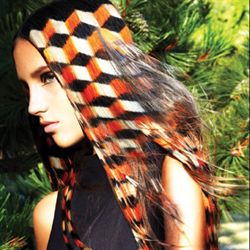
Angelo first worked in the TONI&GUY Academy in Rome, which was much like a basic cosmetology school, but Maurizio Zangheri, who was running the salon in Rome—and who happens to be a TONI&GUY Italy Founder and Bruno Mascolo’s best friend—wanted Angelo to join him in the salon. “He was a wild man!” Angelo remembers. “He would commute to work in one of two ways—in a Ferrari or on a horse!”
The first time Angelo went onto the floor at TONI&GUY, he lost his head. With his first client on his very first day, he tried to combine every technique he had ever learned in one haircut—layers, graduation, slicing, a short crown. The cut took four hours and when he was finished, his boss was furious and immediately pulled him from the floor for six months. “I got carried away,” he shrugs. “But every day is a lesson.”
Angelo served his sentence and once he was back on the floor, he became the top stylist at the salon. He was famous for his clipper cutting—especially hair tattoos where he’d carve mountains and sunsets. His work caught the eye of a young photographer named Mark Havriliak. Mark was shooting all of Zangheri’s collections at the time and noticed Angelo’s passion for his art. “He always had a sketchbook,” Mark told me. “He was always sketching, taking notes. He wanted to know everything about my lighting, how I was shooting.” (Angelo still carries a sketchbook everywhere he goes—it’s always in his bag.)
Mark knew that he had to connect Angelo with another friend of his in London named Trevor Sorbie, who is one of the most accomplished hairdressers ever, and is also responsible for the careers of some of the world’s most talented and accomplished hair artists including Eugene Souleiman, Vivienne Mackinder and Antoinette Beenders. “Trevor Sorbie is one of the best hairdressers of all time,” Angelo explains. “He was always pushing the boundaries, always experimenting. It was during those times in the ’70s and ’80s when they were doing unbelievable things—everyone was living and breathing hair in those days.” So, with just the promise of an interview, nothing more, Angelo left Rome and moved to London.
Antoinette Beenders was Trevor’s International Artistic Director at the time and she gave Angelo his final test before passing him along to Trevor. He passed, got the job and with it, a mentor who would make a profound impact on his life. “When I met Trevor, I asked him one question,” Angelo recalls. “I asked, ‘What is your philosophy?’ His answer was simple: ‘To make women look beautiful.’ That is what I like to do, too. For Trevor and me, we believe that even if the look is strong, the woman must look more beautiful when she leaves the chair than when she sat down in it—no matter whether it’s at a salon or on location.”
Under the direction of Beenders and Souleiman, Angelo began to express his creativity very quickly and developed his own collection. It was called Masquerade, and it earned him his very first British Hairdressing Award in the Avant-Garde category. “I was doing a Victoria’s Secret show with Eugene,” he remembers, “and I showed him the photo. He said it was one of the best things he had ever seen and that I would win with this shot. It is still my personal favorite, even today. The balance of the picture, and the look in her eye as she sees through the opening of the hair—it shows hope.” After that first win, Angelo went on to win British Hairdresser of the Year, three times—in 2006, 2010 and 2012.
Hair Incubation
Angelo once stayed up for 32 hours straight to complete a look he’d started. It wasn’t for a show or an exhibition or on deadline. It was simply that he had something inside him that needed to get out—an idea that had to be created, and he couldn’t stop until it was complete. Some people create because it’s a pleasant adjunct to “real life.” But Angelo creates because he has no choice. It’s what he was born to do, it’s who he is.

The question that every hairdresser always wants to ask any master artist is where their ideas come from, how they build from an initial concept to form it into something that is complete. “It’s like a bird building a nest—a kind of hair incubation,” he laughs. “Nature is very smart and has great processes. The bird starts with the nest and then sits for a long period of time concentrating on creating the eggs and waiting for them to hatch.” It’s the same with hatching ideas. You need to take the time to create—and sometimes take the time to be really quiet and focus. To that point, Angelo believes you have to cleanse your brain by shifting it outside its comfort zone.
For the last several years, Angelo has taken an inspirational retreat for a month in January, always to an unfamiliar place, where the culture is very different. His trip this year was to Peru, Bolivia and Cuba. He spent his days living amongst the locals, walking barefoot through the streets and swimming in the rivers, and taking lots and lots of pictures. Like a gypsy, he wandered from village to village whenever it moved him to do so. He says after these trips, when he returns to London, he’s always cleansed and his mind is open. “I go away so that when I come back, I can see the place I came from with new eyes and new colors.”
Angelo worked for Trevor Sorbie for sixteen years. When he left in 2011, he was the only International Creative Director Trevor had ever appointed to take over the creative direction of his company.
Over the years, Angelo has collaborated with celebrities including Ringo Starr, Naomi Campbell, Gisele Bündchen and Gwyneth Paltrow, and he’s been commissioned to do editorial work for fashion magazines including multiple covers for Italian Vogue, Harper’s Bazaar, Vanity Fair and Dazed & Confused. Fashion has always been a love of Angelo’s and for many years he worked on Eugene Souleiman’s Fashion Week team. “When Eugene became focused on session styling and fashion shows, I worked on his team for fashion weeks in Paris, Milan, London and New York. In fact, for 16 years we worked together doing nearly 50 shows a season. It was great fun, especially the shows for Alexander McQueen and Yohji Yamamoto. But a few years ago, when the economy became really tough, it became very stressful, with lots of tension backstage, and more control over what we did. It became too serious and lost a bit of attraction for me.”
In the last few years, Angelo’s art has also turned to museum and art exhibits, where he has worked on some exclusive shows including: “Appearances Can Be Deceiving: The Dresses 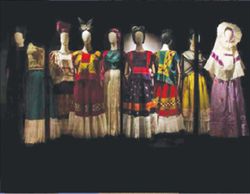 of Frida Kahlo,” an exhibit for the late Mexican muralist whose belongings had been locked away for 50 years. For the exhibit, Angelo dyed hemp (using Frida’s favorite colors) to create hair designs for the nine faceless mannequins wearing her clothing. He also worked on the homage to the late, legendary Vogue and Harper’s Bazaar fashion editor “Diana Vreeland After Diana Vreeland” exhibit in Venice last year at the Museo Fortuny, where he created historically relevant, stunning wigs to complement the designs of fashion luminaries such as Emilio Pucci, Chanel and Paco Rabanne. The exhibit even displayed the original Yves Saint Laurent Mondrian dress from 1965. Angelo was allowed to touch it (wearing gloves) and was incredibly moved by the piece’s profound place in fashion history. Finally, just last year for the Queen’s Jubilee, he did the hair for “Selfridges Britannica 1951-1953,” a fashion exhibition in London honoring some of the most desirable styles worn by the Queen’s contemporaries between 1951 and 1953 and paying creative homage to the Queen’s Diamond Jubilee and the Olympics.
of Frida Kahlo,” an exhibit for the late Mexican muralist whose belongings had been locked away for 50 years. For the exhibit, Angelo dyed hemp (using Frida’s favorite colors) to create hair designs for the nine faceless mannequins wearing her clothing. He also worked on the homage to the late, legendary Vogue and Harper’s Bazaar fashion editor “Diana Vreeland After Diana Vreeland” exhibit in Venice last year at the Museo Fortuny, where he created historically relevant, stunning wigs to complement the designs of fashion luminaries such as Emilio Pucci, Chanel and Paco Rabanne. The exhibit even displayed the original Yves Saint Laurent Mondrian dress from 1965. Angelo was allowed to touch it (wearing gloves) and was incredibly moved by the piece’s profound place in fashion history. Finally, just last year for the Queen’s Jubilee, he did the hair for “Selfridges Britannica 1951-1953,” a fashion exhibition in London honoring some of the most desirable styles worn by the Queen’s contemporaries between 1951 and 1953 and paying creative homage to the Queen’s Diamond Jubilee and the Olympics.
The Complexity of Simplicity
Angelo is quite “simply” one of the most complex men I’ve ever met. He’s simple in that he’s humble, disarmingly unassuming and very genuine. He’s complex because it’s impossible to keep up with the pace of his creativity. Success has not changed Angelo in any way other than increasing the demands on his time to appear on stages across the world. I’ll never forget the first time I saw him on a stage. It was in Bologna, Italy at Cosmoprof three years ago. It was the first show after he was named Artistic Director for Davines. He walked onto the long runway, looking shy and more than a little nervous. He politely said hello and bowed to both sides of the audience. With very little production and almost no talking, Angelo simply worked. Ninety minutes later, the crowd was on its feet.
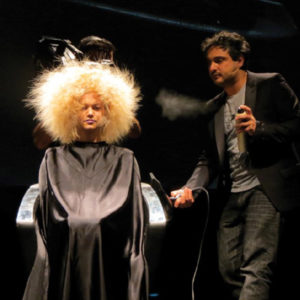
I know Angelo’s not entirely comfortable presenting on stage, and he doesn’t speak much while he’s there, but he doesn’t have to. His audiences are so fascinated by what’s taking place with his hands, that after nearly every presentation, he receives a standing ovation. In Paris, at the Davines World Wide Hair Tour this past June, the audience actually gasped when the camera showed a close up of a pastel model from his Mother Pearl collection. The room often erupts when he demonstrates a simple, time-saving trick the audience had never considered. Angelo makes a deep connection with his audience by respecting them and teaching them things they can use—wearable, current looks and techniques. In today’s hair world, there’s not enough of that going on.
Angelo works with a very small team of one or two assistants who have been with him for years. You’ll never see an entourage supporting him at shows. He is a perfectionist, like all masters, so for him the trust of committed, smart assistants who are quick thinkers backstage outweighs an army any day. His most trusted team member is Edoardo Paludo, Davines’ Colour Director. He is a brilliant colorist and one of his closest friends. Angelo and Edoardo have been working together for more than a decade.
Angelo has been Davines’ International Artistic Director for nearly three years now, and it’s clear he could have chosen almost any hair company to represent. So why Davines? He explains, “Well, we’re both Italian and we understand each other, even though they’re from the north—the civilized region of Italy. It’s still a small brand and they truly believe in sustainability. I love that we can grow together. They have great taste and they try very hard to create something beautiful all the time—with their company, their sustainable products and their people. They have a great team of young people who believe in a better world and I want to work with a company that believes in something besides making money. Plus, I have had a chance to test, and even develop, new products such as Flamboyage, which can change a colorist’s life by giving her the confidence to create different, natural haircolor looks. I also helped to create Pure Colors, an ammonia-free, permanent color range, and the performance is incredible.” Each season, Angelo creates hair collections for Davines complete with video step-bysteps. The looks are taken from his array of knowledge in hair and fashion for the season, and the looks are on-trend and wearable.
Angelo has an extraordinary resume in all facets of hairdressing, so it’s ironic when you talk to him about his personal feelings about hair. “To be honest,” he shares, “I find a woman the most attractive when her hair is natural and she’s wearing no makeup, just wearing herself.”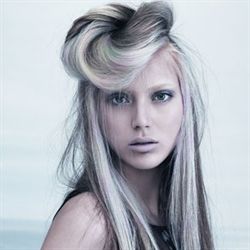 While Angelo’s mind forces him to create that which has never been created before, it’s the simple life he experienced growing up that makes him appreciate the beauty of simplicity. In fact, he believes, “If you think too much with hair, it looks like you think too much. For me, simplicity is always modern. It’s the hardest thing you can ever do, to be simple, even if you don’t think so. It takes discipline to leave the hair alone and not do too much. Also, there’s something I love about hair that isn’t clean—it’s more feminine to me.”
While Angelo’s mind forces him to create that which has never been created before, it’s the simple life he experienced growing up that makes him appreciate the beauty of simplicity. In fact, he believes, “If you think too much with hair, it looks like you think too much. For me, simplicity is always modern. It’s the hardest thing you can ever do, to be simple, even if you don’t think so. It takes discipline to leave the hair alone and not do too much. Also, there’s something I love about hair that isn’t clean—it’s more feminine to me.”
The complexity of simplicity is found in the man as well. I believe Angelo is a gypsy, juxtaposed with the fact that he’s organized and committed to his responsibilities. But like a gypsy, his artist’s mind is always free, traveling like a bird from place to place. You can see it in his eyes and hear it in his voice when he is wandering into a new creative space. Angelo always says, “Hair is like an illness, you get sick with it.” What he doesn’t understand is that his brilliance infects all of us, including me. I, along with everyone else, am a student of his creative curation, a voyeur trying to get a front row seat to how his mind works and where he’s going next. But, one thing is clear. It will be somewhere none of us, including him, has ever been before.
More from
Angelo Seminara
-
Events
Kao Salon Announces Virtual Experience Event Dates
-
Industry News
Angelo Seminara Signs As Goldwell Global Ambassador
-
Demi-Permanent Color
Davines Launches New Demi-Permanent Haircolor Collection
-
Events
Davines World Wide Hair Tour 2018
-
Hair Color
Learn Angelo Seminara’s Creative Color “Imprinting” Technique
-
Collections
The Enchanting
-
Angelo Seminara
Into the Woods
-
Events
The 2016 British Hairdressing Awards Winners Are Here!
-
New Appointments
BREAKING NEWS: Angelo Seminara to Partner with Great Lengths
-
Hair Color
Hand-Crafted Hair Movement
-
Angelo Seminara
BTC Exclusive: Souls by Angelo Seminara
-
Angelo Seminara
Woodland from Davines
-
Angelo Seminara
Playground from Angelo Seminara
-
Angelo Seminara
Mother of Pearl Collection from Davines
-
Balayage
Mother of Pearl Blonde by Angelo Seminara
-
Angelo Seminara
MIXTE: The Winning Collection by Angelo Seminara, 2012 British Hairdresser of the Year
-
Angelo Seminara
Living Jewels from Angelo Seminara for Davines
-
Angelo Seminara
POWDER by Angelo Seminara for Davines
-
Angelo Seminara
Heroines, by Angelo Seminara
-
Angelo Seminara
Angelo Seminara’s “Wonderland”
-
Angelo Seminara
BTC EXCLUSIVE: Flamboyance by Angelo Seminara for Davines
-
Angelo Seminara
The Ten Collection from Angelo Seminara
-
Angelo Seminara
Náttúra by Angelo Seminara for Davines








